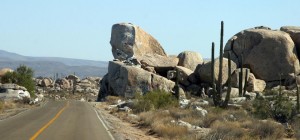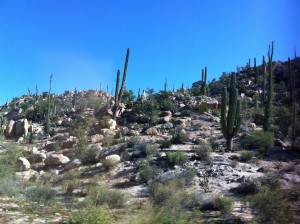Everywhere we travel, it seems that we are noticing more of something terribly out of place in nature and on man-made structures: people are “tagging” with graffiti. The graffiti shows up in many forms such as names, dates, political or religious statements, drawings, profanity or expressions of love, just to name a few.
I suppose that leaving a mark is in our nature as human beings. From the earliest cultures, we have found evidence of their stories and people left signs of their presence. These marks are part of our history and date back hundreds and thousands of years. The world is a different place now and it would be a much more beautiful world if members of society would chose to protect places of beauty and find an alternative way to leave their mark.
One of the most beautiful and amazing places we see on our trip up and down the Baja is the Cataviña Boulder Field. The Field runs for miles and miles and the hills and valleys are filled with tens of thousands of magnificent, building-sized boulders, gigantic rock formations and amazing cacti. This area, known as Baja’s rock garden, has unfortunately been “tagged” by people who feel they need to leave their mark.
On our way to California last year, we were delighted to see that someone attempted to cover the graffiti with beige paint to match the color of the boulders. By this year, however, many of the rocks were again “tagged”, but fewer than in years past. This entire region is under the protection of the Parque Natural del Desierto Central de Baja California, so perhaps they have been the party responsible for covering the defacement, or perhaps there are some dedicated good Samaritans who have taken that responsibility onto themselves. Whoever it is, we’re grateful.
There is a little white house across and down the street from us that we pass every time we drive to our home. Because the property is deserted, it is constantly defaced with graffiti. Every year, we purchase white paint and try to send a message that the “tagging” won’t be tolerated by painting over the graffiti with fresh white paint. My fear is that the “artists” just see us providing a new, blank canvas every time we do that. Oh well, perhaps more people will get the message.
I find it very sad that “tagging” has become such an accepted way for people to leave a mark. Make memories with photos when you’re travelling through places like Cataviña instead of defacing the boulders, write an editorial if you need to make a political statement, write a book, mentor someone, leave a legacy and just live your life as you’d like to be remembered and eulogized – that’s a much better way for each of us to leave evidence that we existed.

![photo[1]](https://cookingwithfire.com/wp-content/uploads/2013/12/photo1-225x300.jpg)


![photo[2]](https://cookingwithfire.com/wp-content/uploads/2013/12/photo2-300x225.jpg)
